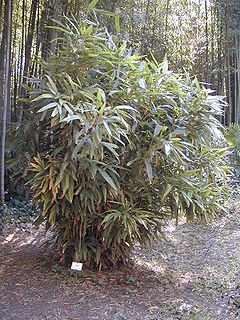
Indocalamus is a genus of about 35 species of flowering plants in the grass family Poaceae, native to China, Vietnam and Japan. They are quite small evergreen bamboos normally up to 2 m (6.6 ft) in height, initially forming clumps and then spreading to form larger thickets. They have thick, glossy leaves. Ruo leaves use to wrap foods like rice during dragon boat festival, originate in fujian refer to Indocalamus longiauritusoriginally but now are nonspecific to just about any leaf wrap.

Adenophora is a genus of flowering plants in the family Campanulaceae, the bellflowers. Plants of this genus are known commonly as ladybells. Most are native to eastern Asia, with a few in Europe. Many are endemic to either China or Siberia.

The peach blossom is a moth of the family Drepanidae. It was first described by Carl Linnaeus in his 1758 10th edition of Systema Naturae.

Osmanthus is a genus of about 30 species of flowering plants in the family Oleaceae. Most of the species are native to eastern Asia with a few species from the Caucasus, New Caledonia and Sumatra.

Triadica is a plant genus of the family Euphorbiaceae first described as a genus in 1790. It is native to eastern southeastern, and southern Asia.
- Triadica cochinchinensisLour. - China, Cambodia, Assam, Bangladesh, Bhutan, Nepal, Himalayas of E + N India, Borneo, Sulawesi, Sumatra, Laos, Malaysia, Myanmar, Philippines, Thailand, Vietnam
- Triadica rotundifolia(Hemsl.) Esser - Guangdong
- Triadica sebifera(L.) Small - China, Japan; naturalized in Himalayas, Cuba, Puerto Rico, SE + SC USA, Sacramento Valley in N California
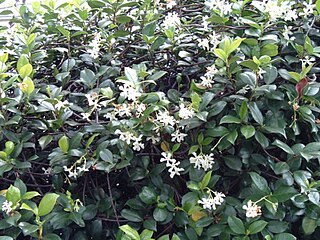
TrachelospermumStar Jasmine, Confederate Jasmine, is a genus of evergreen woody vines in the dogbane family Apocynaceae, first described as a genus in 1851. All species are native to southern and eastern Asia.

Rohdea is a genus of native to eastern Asia. It was long thought to contain only a single species, R. japonica, but recent studies have resulted in several other taxa being transferred into the genus.

Aletris, the colicroot, colicweed, crow corn, or unicorn root, is a genus of flowering plants in the Nartheciaceae family, native to North America and to eastern and southeastern Asia, especially China. It was used as a component in Lydia Pinkham's original Vegetable Compound.
Neopanorpa is a genus with ca. 170 species of scorpionflies of Southeast Asia. The genus Leptopanorpa was found to be nested within Neopanorpa, making it paraphyletic.

The genus Helwingia consists of shrubs or rarely small trees native to eastern Asia, the Himalayas, and northern Indochina. It is the only genus in the family Helwingiaceae.
Neyraudia is a genus of Asian and African plants in the grass family.

Oreorchis is a genus of flowering plants from the orchid family, Orchidaceae. It is native to Asia. Species currently accepted as of June 2014:
- Oreorchis angustataL.O.Williams ex N.Pearce & P.J.Cribb - Sichuan, Yunnan
- Oreorchis aurantiacaP.J.Cribb & N.Pearce - Myanmar
- Oreorchis bilamellataFukuy. - Taiwan
- Oreorchis discigeraW.W.Sm. - Myanmar
- Oreorchis erythrochryseaHand.-Mazz. - Tibet, Sichuan, Yunnan
- Oreorchis fargesiiFinet - Fujian, Gansu, Hubei, Hunan, Shaanxi, Sichuan, Taiwan, Yunnan, Zhejiang
- Oreorchis foliosa(Lindl.) Lindl. - India, Assam, Nepal, Bhutan, Myanmar, Tibet, Sichuan, Taiwan, Yunnan
- Oreorchis itoana(F.Maek.) Perner - Honshu
- Oreorchis micranthaLindl. - Tibet, Taiwan, Assam, India, Bhutan, Nepal, Myanmar
- Oreorchis nanaSchltr. - Sichuan, Yunnan, Hubei
- Oreorchis nepalensisN.Pearce & P.J.Cribb - Nepal, Tibet
- Oreorchis oliganthaSchltr. - Gansu, Sichuan, Tibet, Yunnan
- Oreorchis parvulaSchltr. - Sichuan, Yunnan
- Oreorchis patens(Lindl.) Lindl. - Japan, Korea, Russian Far East, China
- Oreorchis porphyranthesTuyama - Nepal
- Oreorchis sanguinea(N.Pearce & P.J.Cribb) N.Pearce & P.J.Cribb - Bhutan

Rhopobota naevana, the holly tortrix moth, holly leaf tier or blackheaded fireworm, is a moth of the family Tortricidae. It is found from Europe to eastern Russia, China, Taiwan, Mongolia, Korea and Japan. It is also present in India, Sri Lanka and North America.
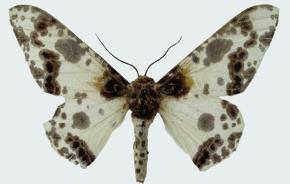
Biston panterinaria is a moth of the family Geometridae. It is found in China, India, Nepal, Sikkim, Vietnam and Thailand.

Habrosyne indica is a moth in the family Drepanidae. It is found from India to Taiwan and Japan.
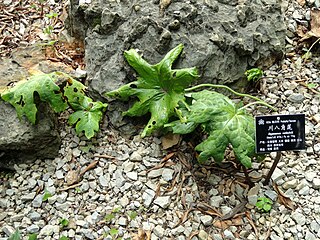
Dysosma is a group of herbaceous perennials in the Berberidaceae or barberry family described as a genus in 1928. It is native to China and Indochina.

Pingasa alba is a moth of the family Geometridae first described by Charles Swinhoe in 1891. It is found in the Chinese provinces of Hubei, Hunan, Guangxi, Zhejiang, Yunnan, Fujian, Guizhou, Jiangxi and Sichuan, and in Taiwan and Japan.
Lemyra melli is a moth of the family Erebidae. It was described by Franz Daniel in 1943. It is found in China.
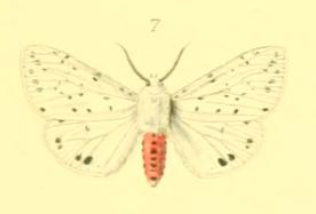
Spilosoma punctaria is a moth in the family Erebidae. It was described by Caspar Stoll in 1782. It is found in the Russian Far East, China, Korea, Taiwan and Japan.

Mosla is a genus of plants in the family Lamiaceae, first described as a genus in 1875. It is native to eastern Asia, the Himalayas, and southeastern Asia.
- Mosla bracteataDoan ex Suddee & A.J.Paton - Vietnam
- Mosla cavalerieiH.Lév.- Vietnam, Guangdong, Guangxi, Guizhou, Hubei, Jiangxi, Sichuan, Yunnan, Zhejiang
- Mosla chinensisMaxim. - Vietnam, Korea, Japan, Anhui, Fujian, Guangdong, Guangxi, Guizhou, Hubei, Hunan, Jiangsu, Jiangxi, Shandong, Sichuan, Taiwan, Zhejiang
- Mosla coreanaH.Lév. - Korea
- Mosla dianthera(Buch.-Ham. ex Roxb.) Maxim. - China, Japan, Korea, Ryukyu Islands, Kuril Islands, Primorye, Caucasus, Himalayas, Myanmar, Vietnam, Philippines, Sumatra
- Mosla exfoliata(C.Y.Wu) C.Y.Wu & H.W.Li - Sichuan
- Mosla hangchouensisMatsuda - Zhejiang
- Mosla japonica(Benth. ex Oliv.) Maxim. - Japan, Korea, Ryukyu Islands
- Mosla longibracteata(C.Y.Wu & S.J.Hsuan) C.Y.Wu & H.W.Li - Guangxi, Zhejiang
- Mosla longispica(C.Y.Wu) C.Y.Wu & H.W.Li - Jiangxi
- Mosla pauciflora(C.Y.Wu) C.Y.Wu & H.W.Li - Guizhou, Hubei, Sichuan
- Mosla punctulataNakai - Korea, Taiwan, Japan, China
- Mosla scabra(Thunb.) C.Y.Wu & H.W.Li - Vietnam, Korea, Japan, Ryukyu Islands, Anhui, Fujian, Gansu, Guangdong, Guangxi, Henan, Hubei, Hunan, Jiangsu, Jiangxi, Liaoning, Shaanxi, Sichuan, Taiwan, Zhejiang
- Mosla soochouensisMatsuda - Anhui, Jiangsu, Jiangxi, Zhejiang
- Mosla tamdaoensisPhuong - Vietnam















